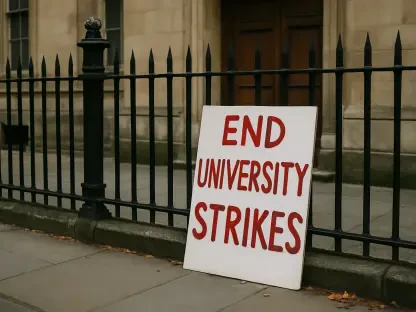Imagine a nation’s military leadership shaped by policies that ignite fierce debate over fairness and readiness—a debate so intense that lawsuits challenging race-conscious admissions at esteemed institutions like West Point and the Air Force Academy have made headlines. This contentious issue, centered on how diversity and merit intersect in military education, has evolved dramatically with Students for Fair Admissions (SFFA) recently dropping its legal challenges against these academies. The shift comes after significant policy changes under the current administration. This roundup dives into a collection of opinions, insights, and analyses from various stakeholders, including legal experts, military officials, and policy advocates, to unpack why this decision unfolded and what it signals for the future of admissions in military academies. The purpose is to present a balanced view of differing perspectives on this polarizing topic and explore its broader implications.
Exploring the Legal Shift: Why SFFA Stepped Back
Background of the Legal Battle
The journey to SFFA’s decision to withdraw lawsuits against military academies begins with a landmark Supreme Court ruling a couple of years ago that banned race-based admissions in civilian colleges while carving out an exception for military institutions due to national security interests. This distinction fueled SFFA’s targeted legal challenges against West Point and the Air Force Academy, arguing that race should not factor into admissions decisions even in a military context. Legal analysts note that the group’s mission has long centered on dismantling affirmative action across all educational spheres, viewing any race-conscious policy as a deviation from merit-based standards.
Differing views emerge when examining the initial traction of these lawsuits. Some legal scholars suggest that SFFA’s cases gained momentum by highlighting disparities in admissions criteria, pointing to publicly available data on acceptance rates across racial groups. Others argue that the lawsuits faced an uphill battle from the start, given the judiciary’s historical deference to military needs over civilian norms. This split in opinion underscores the complexity of applying broad legal principles to specialized institutions with unique mandates.
Impact of Recent Policy Changes
A pivotal factor in SFFA’s withdrawal stems from a swift policy overhaul under the current Defense Department leadership, which banned race-conscious admissions earlier this year. Policy experts aligned with anti-affirmative action stances praise this move as a victory for colorblind principles, asserting that it directly addressed SFFA’s core grievances without necessitating prolonged litigation. They argue that such alignment reflects a growing national trend toward prioritizing individual qualifications over group-based considerations.
On the flip side, advocates for diversity in military education express concern over the abrupt policy shift. Many in this camp, including former military officials, contend that the ban overlooks the strategic value of a diverse officer corps in fostering unit cohesion and operational effectiveness. They warn that reversing decades of diversity initiatives could have unintended consequences on recruitment and retention of talent from varied backgrounds, potentially impacting long-term readiness.
Diving Into the Core Debate: Diversity Versus Merit in Military Academies
Balancing Representation with Qualifications
At the heart of this issue lies a fundamental clash between advocating for diversity as a national security asset and pushing for admissions based solely on merit. Supporters of race-conscious policies, including some military educators, emphasize that a leadership reflective of the nation’s demographic makeup strengthens trust and communication within the armed forces. They argue that diversity in training environments prepares cadets to lead in real-world scenarios where cultural competence is critical.
Critics, often aligned with SFFA’s mission, counter that focusing on race risks diluting standards critical for military performance. Legal advocates in this group highlight past complaints against academies like West Point, which claimed an overemphasis on racial quotas compromised the selection of the most qualified candidates. This perspective insists that leadership roles must prioritize measurable skills and achievements over identity factors to ensure operational excellence.
A third angle comes from neutral policy analysts who suggest a hybrid approach, combining objective metrics with contextual factors like socioeconomic background rather than race alone. This middle ground, they argue, could address fairness concerns while maintaining a commitment to varied perspectives in military leadership. Such a proposal aims to bridge the ideological divide but remains largely untested in practice.
Legal Precedents Shaping the Discourse
The legal framework surrounding this debate has been heavily influenced by recent Supreme Court decisions, which allowed military academies to retain race-based policies even as civilian institutions faced bans. Legal commentators favoring SFFA’s stance argue that this exemption created a double standard, prompting justified lawsuits to test the boundaries of military-specific justifications. They note that ongoing ambiguity in legal interpretations could invite future challenges if policies fluctuate again.
Conversely, defenders of the exemption stress that the court’s reasoning was rooted in evidence showing diversity as essential to military effectiveness, particularly in international operations requiring cultural awareness. Some military law experts point out that without such policies, academies might struggle to build a pipeline of leaders equipped for modern warfare’s complexities. This viewpoint underscores the unique role academies play compared to civilian colleges.
A balanced take from judicial observers highlights the precarious nature of relying on judicial carve-outs amid shifting political landscapes. They caution that while current lawsuits are dropped, the lack of definitive legal clarity means similar disputes could resurface, especially if future administrations revisit diversity mandates. This uncertainty keeps the legal dimension of admissions policies in a state of flux.
Policy Overhauls and Administrative Influence
The rapid ban on race-conscious admissions under the current Defense Secretary has drawn polarized reactions. Proponents of the policy, including conservative think tanks, view it as a necessary correction to what they see as discriminatory practices, aligning military academies with broader societal pushes for equal treatment under law. They celebrate the consistency this brings across different academies, rendering legal challenges like those against the Naval Academy obsolete.
Opponents, including progressive military reform groups, argue that such top-down changes disregard the nuanced needs of military education. They cite concerns from within academy alumni networks that abandoning diversity-focused admissions could narrow the talent pool, especially as the nation’s demographics evolve. This critique questions whether short-term ideological wins might undermine long-term strategic goals.
A pragmatic perspective from defense policy consultants suggests that while the ban resolves immediate legal tensions, its durability remains in doubt. They note that historical patterns of policy reversal with changing administrations could destabilize academy admissions frameworks, urging stakeholders to prepare for potential swings in approach over the next few years, from this year to 2027. This cautionary stance emphasizes adaptability as a key factor in navigating future uncertainties.
Cultural Implications Beyond Admissions Criteria
Beyond the admissions debate, broader cultural shifts within military academies have sparked discussion due to actions like purging library materials on racism and gender issues. Traditionalist voices defend these moves as refocusing military education on core combat readiness, arguing that ideological content distracts from essential training. They see such reforms as aligning academies with a no-nonsense ethos befitting military discipline.
Critics, including educational policy advocates, decry these changes as stifling critical thinking among cadets, who need exposure to diverse ideas to lead in a multifaceted world. They worry that narrowing intellectual resources could produce leaders less equipped to handle societal challenges within and outside the military. This concern highlights a deeper rift over what constitutes appropriate preparation for future officers.
A nuanced view from military historians draws parallels to past debates over training environments, suggesting that while cultural reforms may aim for efficiency, they risk alienating segments of potential recruits who value inclusive learning spaces. This historical lens warns of a potential disconnect between academy culture and the broader society officers are meant to serve, posing questions about long-term recruitment strategies.
Key Takeaways from Varied Voices
Synthesizing these perspectives reveals a multifaceted issue with no easy resolution. Legal experts underscore that SFFA’s withdrawal of lawsuits reflects a temporary alignment with current policy banning race-based admissions, yet the underlying legal ambiguity persists. Military voices advocating diversity stress its operational necessity, while opponents champion merit as the sole criterion for leadership selection. Policy analysts and cultural commentators add layers of concern over stability and intellectual breadth, painting a picture of an ongoing struggle between competing values.
A notable consensus emerges on the need for clarity and adaptability—whether through revised admissions frameworks or robust dialogue on military education’s purpose. Some stakeholders propose pilot programs to test alternative admissions models that balance qualifications with broader contextual factors, offering a potential path forward. Others emphasize the importance of monitoring how these policy shifts impact cadet demographics and military performance over time.
Reflecting on the Path Forward
Looking back, the discourse surrounding SFFA’s dropped lawsuits against military academies revealed a deeply divided landscape where legal, cultural, and strategic priorities collided. The insights gathered from diverse sources illuminated the stakes involved, from ensuring fairness in admissions to preserving readiness for national defense. As this chapter closed with policy alignment favoring colorblind approaches, the debates it sparked lingered as critical lessons for future policy-making.
Moving ahead, stakeholders are encouraged to delve deeper into data-driven assessments of how admissions policies affect military outcomes, advocating for transparent metrics to guide decisions. Engaging in cross-sector dialogues—bringing together military leaders, legal minds, and educators—could foster innovative solutions that honor both merit and diversity. Keeping abreast of evolving policies and their real-world impacts remains essential, ensuring that the shaping of tomorrow’s military leadership reflects a thoughtful balance of competing ideals.









